Volume 51, Number 14, December 2003
Updated: 2010-04-30 08:34:33
Planetary and Space Science, Volume 51, Number 14, December 2003.
Loaded on 2003-12-06
 There are millions of asteroids in the asteroid belt between Mars and Jupiter, but yesterday attention focused on just one. According to a couple of studies in Nature, a large asteroid called 24 Themis is rife with water ice and organic molecules, and the researchers say that it could be more evidence that the water [...]
There are millions of asteroids in the asteroid belt between Mars and Jupiter, but yesterday attention focused on just one. According to a couple of studies in Nature, a large asteroid called 24 Themis is rife with water ice and organic molecules, and the researchers say that it could be more evidence that the water [...] Ready for another Where In The Universe Challenge? Here's #102! Take a look and see if you can name where in the Universe this image is from. Give yourself extra points if you can name the spacecraft responsible for the image. We provide the image today, but won’t reveal the answer until tomorrow. This gives [...]
Ready for another Where In The Universe Challenge? Here's #102! Take a look and see if you can name where in the Universe this image is from. Give yourself extra points if you can name the spacecraft responsible for the image. We provide the image today, but won’t reveal the answer until tomorrow. This gives [...] I've now posted the answer in the original post.
Check back next week for another Universe Puzzle!© Jean Tate for Universe Today, 2010. |
Permalink |
No comment |
Add to
del.icio.usPost tags:Feed enhanced by Better Feed from Ozh
I've now posted the answer in the original post.
Check back next week for another Universe Puzzle!© Jean Tate for Universe Today, 2010. |
Permalink |
No comment |
Add to
del.icio.usPost tags:Feed enhanced by Better Feed from Ozh
 Wow — this looks HUGE from orbit — can you imagine standing out in the Sahara Desert and seeing this gigantic wall of dust heading right towards you? The Moderate Resolution Imaging Spectroradiometer (MODIS) on NASA’s Aqua satellite observed this wall of dust on April 22, 2010 which spans hundreds of kilometers. See [...]
Wow — this looks HUGE from orbit — can you imagine standing out in the Sahara Desert and seeing this gigantic wall of dust heading right towards you? The Moderate Resolution Imaging Spectroradiometer (MODIS) on NASA’s Aqua satellite observed this wall of dust on April 22, 2010 which spans hundreds of kilometers. See [...] Our series "13 Things That Saved Apollo 13" has raised a few questions for some of our readers about spacecraft design, decisions made during the Apollo program, and general questions about spaceflight. Some of you have already left questions as comments on the articles or sent in emails. NASA engineer Jerry Woodfill, who [...]
Our series "13 Things That Saved Apollo 13" has raised a few questions for some of our readers about spacecraft design, decisions made during the Apollo program, and general questions about spaceflight. Some of you have already left questions as comments on the articles or sent in emails. NASA engineer Jerry Woodfill, who [...] We usually think of asteroids as dark, dry, lifeless chunks of rock, just like the image of Asteroid Itokawa, above. But some asteroids may be more like "minor planets" after all. Researchers have found evidence on one asteroid – 24 Themis – of water ice and organic materials. This discovery is exciting [...]
We usually think of asteroids as dark, dry, lifeless chunks of rock, just like the image of Asteroid Itokawa, above. But some asteroids may be more like "minor planets" after all. Researchers have found evidence on one asteroid – 24 Themis – of water ice and organic materials. This discovery is exciting [...] I’m on the road today, so I don’t have time to explain the fascinating science behind this freaky new picture of feathered dinosaurs young and old. So let me just direct your attention to fellow D-blogger, Ed Yong, and Nature’s Janet Fang for more.
[Image by Xing Lida and Song Qijin]
I’m on the road today, so I don’t have time to explain the fascinating science behind this freaky new picture of feathered dinosaurs young and old. So let me just direct your attention to fellow D-blogger, Ed Yong, and Nature’s Janet Fang for more.
[Image by Xing Lida and Song Qijin]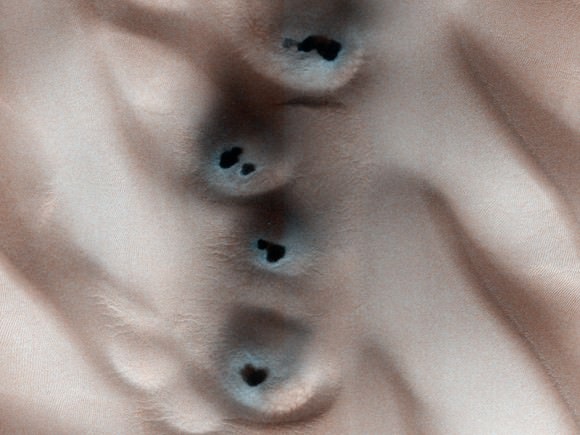 With Mars seemingly the destination of choice in NASA's future, researchers are taking a look at what kinds of things we want to bring with us when we go to Mars. But also, just as important is what we don't want to take with us. A new study by the University of Central [...]
With Mars seemingly the destination of choice in NASA's future, researchers are taking a look at what kinds of things we want to bring with us when we go to Mars. But also, just as important is what we don't want to take with us. A new study by the University of Central [...] : , , , . Log In Subscribe Give a Gift Archives Customer Service SEARCH Health Medicine Mind Brain Technology Space Human Origins Living World Environment Physics Math Video Photos Podcast RSS Blogs Discoblog Stem Cell-Powered Worm Doesn’t Age , Can Grow a New Head Scout’s Honor : I’m Only Playing This Video Game to Earn My Merit Badge NCBI ROFL : I’d like a number 2 value meal , a frosty , and a peer-reviewed publication , . please An observational study of consumer use of fast-food restaurant drive-through lanes : implications for menu labelling . policy OBJECTIVE : The present study was designed to quantify the number of customers who purchase fast food through drive-in windows as a means of informing legislative labelling efforts . DESIGN : This was an observational study . SETTING :
: , , , . Log In Subscribe Give a Gift Archives Customer Service SEARCH Health Medicine Mind Brain Technology Space Human Origins Living World Environment Physics Math Video Photos Podcast RSS Blogs Discoblog Stem Cell-Powered Worm Doesn’t Age , Can Grow a New Head Scout’s Honor : I’m Only Playing This Video Game to Earn My Merit Badge NCBI ROFL : I’d like a number 2 value meal , a frosty , and a peer-reviewed publication , . please An observational study of consumer use of fast-food restaurant drive-through lanes : implications for menu labelling . policy OBJECTIVE : The present study was designed to quantify the number of customers who purchase fast food through drive-in windows as a means of informing legislative labelling efforts . DESIGN : This was an observational study . SETTING :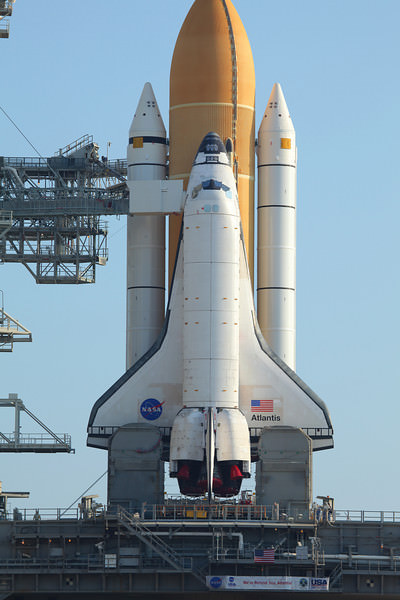 A switch-out of the magnet for a much anticipated particle physics experiment on the International Space Station will force NASA to delay the final flight of the space shuttle until at least November, and change which orbiter and crew will fly the final space shuttle mission. The $2 billion Alpha Magnetic Spectrometer was scheduled [...]
A switch-out of the magnet for a much anticipated particle physics experiment on the International Space Station will force NASA to delay the final flight of the space shuttle until at least November, and change which orbiter and crew will fly the final space shuttle mission. The $2 billion Alpha Magnetic Spectrometer was scheduled [...]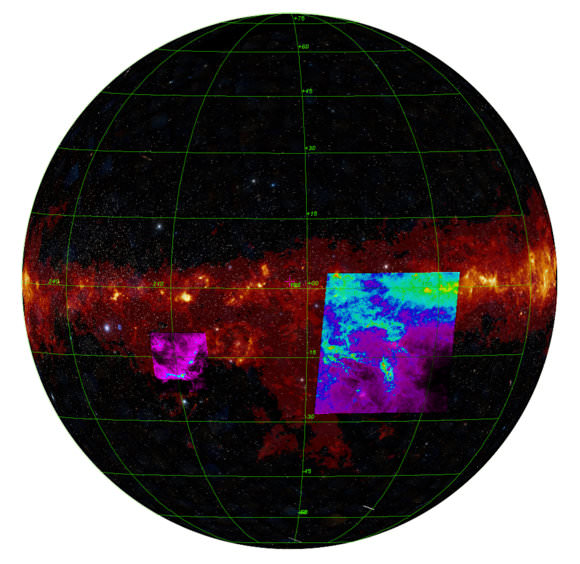 While most newborn stars are hidden beneath a blanket of gas and dust, the Planck space observatory – with its microwave eyes – can peer beneath that shroud to provide new insights into star formation. The latest images released by the Planck team bring to light two different star forming regions in the Milky [...]
While most newborn stars are hidden beneath a blanket of gas and dust, the Planck space observatory – with its microwave eyes – can peer beneath that shroud to provide new insights into star formation. The latest images released by the Planck team bring to light two different star forming regions in the Milky [...] How did you do in last week's Universe Puzzle?
Do you enjoy these puzzles? What do you particularly like? Dislike? Would like to see changed? Would like to see more of? Let me know please!
Once again, this week's puzzle requires you to cudgel your brains a bit and do some lateral thinking (five minutes spent googling [...]
How did you do in last week's Universe Puzzle?
Do you enjoy these puzzles? What do you particularly like? Dislike? Would like to see changed? Would like to see more of? Let me know please!
Once again, this week's puzzle requires you to cudgel your brains a bit and do some lateral thinking (five minutes spent googling [...] When considering how the solar system formed, there are a number of problems with the idea of planets just blobbing together out of a rotating accretion disk. The Nice model (and OK, it’s pronounced ‘niece’ – as in the French city) offers a better solution.(...)Read the rest of Astronomy Without A Telescope – The Nice [...]
When considering how the solar system formed, there are a number of problems with the idea of planets just blobbing together out of a rotating accretion disk. The Nice model (and OK, it’s pronounced ‘niece’ – as in the French city) offers a better solution.(...)Read the rest of Astronomy Without A Telescope – The Nice [...] Note: To celebrate the 20th anniversary of the Hubble Space Telescope, for ten days, Universe Today has featured highlights from two year slices of the life of the Hubble, focusing on its achievements as an astronomical observatory. Today's article looks at the last two years, to April 2010.
The stakes for the fifth, and final, Hubble [...]
Note: To celebrate the 20th anniversary of the Hubble Space Telescope, for ten days, Universe Today has featured highlights from two year slices of the life of the Hubble, focusing on its achievements as an astronomical observatory. Today's article looks at the last two years, to April 2010.
The stakes for the fifth, and final, Hubble [...] Happy 20th Birthday to the Hubble Space Telescope! While we should be showering HST with gifts, instead the telescope provides this present to us: an amazing view of what has been nicknamed "Mystic Mountain. " It is just a small portion of one of the largest known star-birth regions in the galaxy, [...]
Happy 20th Birthday to the Hubble Space Telescope! While we should be showering HST with gifts, instead the telescope provides this present to us: an amazing view of what has been nicknamed "Mystic Mountain. " It is just a small portion of one of the largest known star-birth regions in the galaxy, [...] Everything in the Universe is spinning. In fact, without this rotation, life on Earth wouldn't exist. We need the conservation of angular momentum to flatten out galaxies and solar systems, to make planets possible. Let's find out about the physics involved with everything that spins, and finally figure out the difference between centripetal and centrifugal [...]
Everything in the Universe is spinning. In fact, without this rotation, life on Earth wouldn't exist. We need the conservation of angular momentum to flatten out galaxies and solar systems, to make planets possible. Let's find out about the physics involved with everything that spins, and finally figure out the difference between centripetal and centrifugal [...] The Hubble Space Telescope is 20 years old on Saturday and, to mark this anniversary, all the world's space and astronomy fans have a chance to become part of the Hubble team.
As part of the birthday celebrations NASA’s Space Telescope Science Institute and the online astronomy project Galaxy Zoo are making some 200,000 Hubble images [...]
The Hubble Space Telescope is 20 years old on Saturday and, to mark this anniversary, all the world's space and astronomy fans have a chance to become part of the Hubble team.
As part of the birthday celebrations NASA’s Space Telescope Science Institute and the online astronomy project Galaxy Zoo are making some 200,000 Hubble images [...]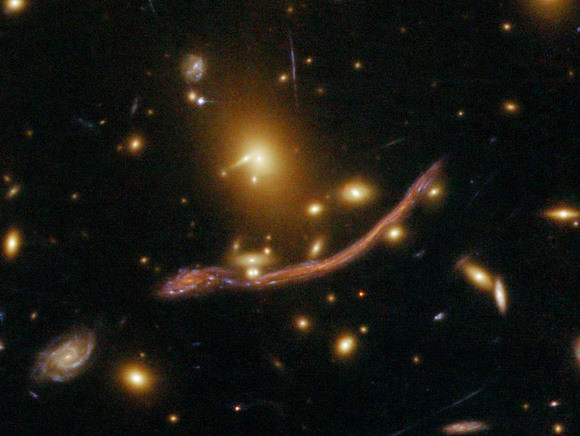 We're on to the next cto, yibai, cien, cento, hundred of Where In The Universe Challenges. You know what to do: take a look at this image and see if you can determine where in the universe this image is from; give yourself extra points if you can name the instrument responsible for the [...]
We're on to the next cto, yibai, cien, cento, hundred of Where In The Universe Challenges. You know what to do: take a look at this image and see if you can determine where in the universe this image is from; give yourself extra points if you can name the instrument responsible for the [...]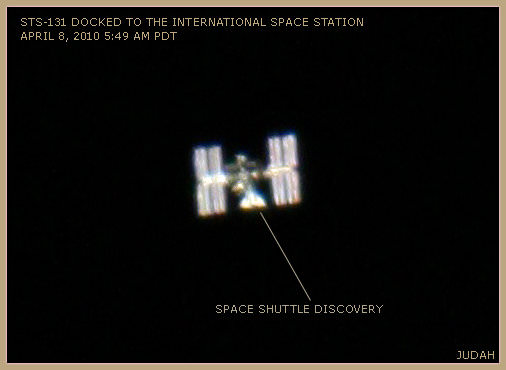 This has to be one of the clearest close-up shots of the International Space Station ever taken from the ground! Plus it has the added bonus of having space shuttle Discovery docked to the station. Ted Judah, who lives in northern California captured this image — one of 150 he took during the an [...]
This has to be one of the clearest close-up shots of the International Space Station ever taken from the ground! Plus it has the added bonus of having space shuttle Discovery docked to the station. Ted Judah, who lives in northern California captured this image — one of 150 he took during the an [...] David Bradley Science Writer
A meteoric storm raged over the Earth 13,000 years ago as thousands of pieces of rock each the size of the Tunguska comet rained down over the course of an hour. The end result was a dramatic cooling of the planet, according to astronomer Bill Napier of the Cardiff University Astrobiology Centre.
Writing [...]
David Bradley Science Writer
A meteoric storm raged over the Earth 13,000 years ago as thousands of pieces of rock each the size of the Tunguska comet rained down over the course of an hour. The end result was a dramatic cooling of the planet, according to astronomer Bill Napier of the Cardiff University Astrobiology Centre.
Writing [...]